Wendy Red Star reimagines a 19th century Indigenous gathering at the Broad
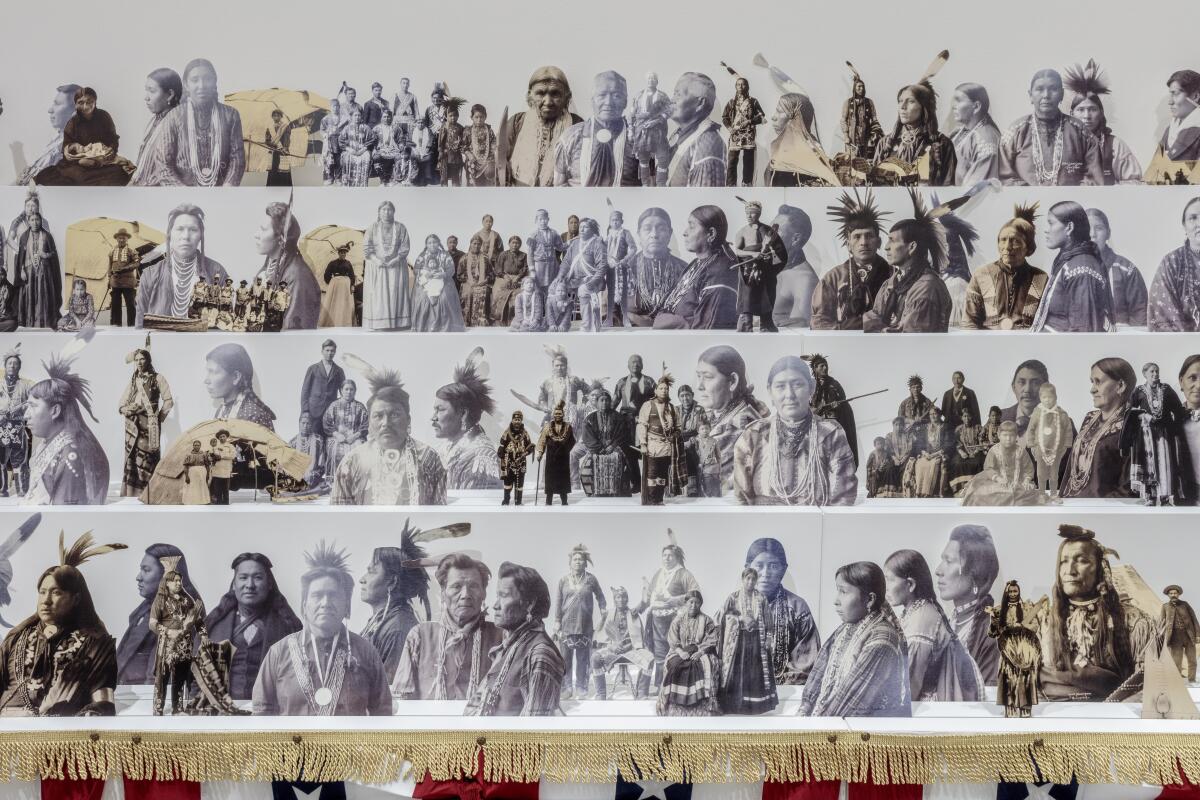
- Share via
How many mangonada paletas can I eat in this heat? I’m about to find out. I’m Carolina A. Miranda, arts and urban design columnist at the Los Angeles Times, delivering an extra toasty edition of the week’s essential arts news:
Reuniting an Indian gathering
Step into an alcove at the Broad museum and you will find yourself in the middle of an important Indigenous summit. Here is Chief Black Hawk of the Winnebago, decked out in a patterned robe. There is Chief Goes to War (Sioux), in feathered headdress and beaded breast plate. Bear Woman (Arapaho) sits in a tunic of fringed leather, as Freckle Face stands above her in a long skirt and patterned shawl. Welcoming everyone to the proceedings, as a larger-than-life image adhered to one wall, is White Swan, an Apsáalooke (Crow) citizen, who, over the course of a storied life, served as a military scout for Gen. Custer and later became a noted ledger artist.
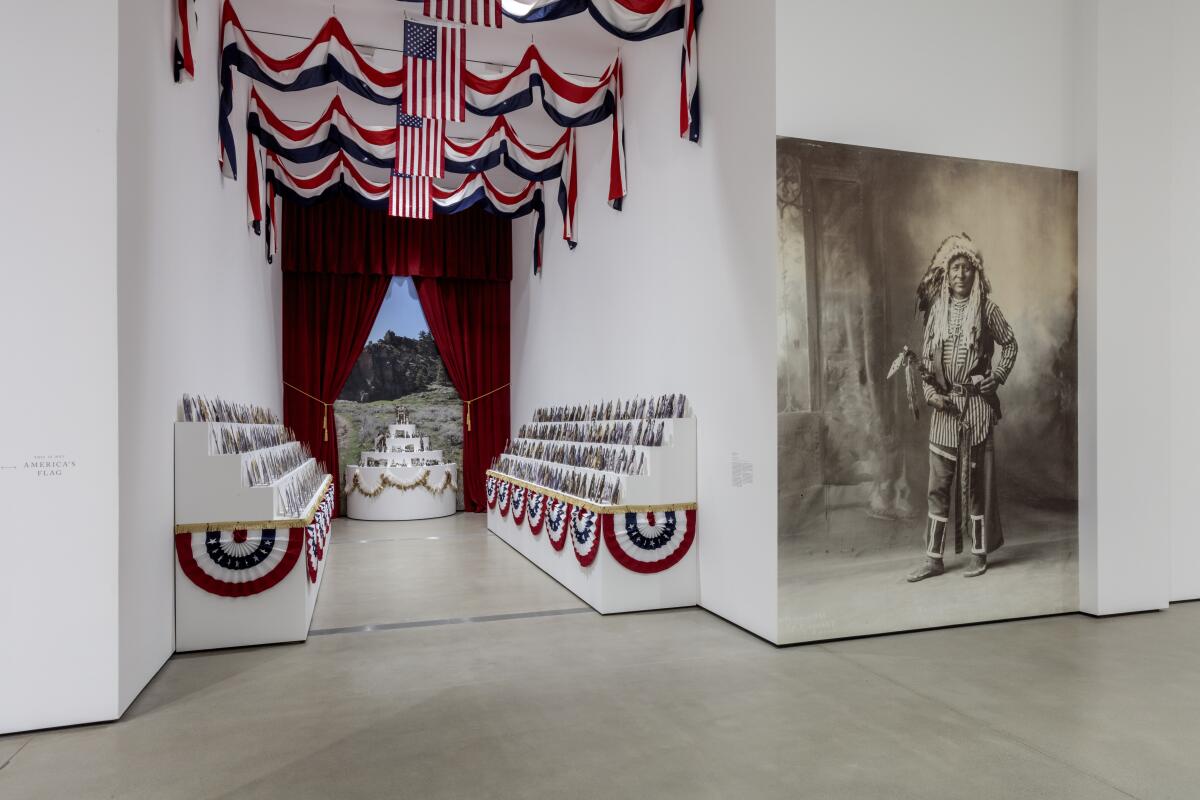
This remarkable gathering was staged by Oregon-based artist Wendy Red Star, who is also of Apsáalooke heritage. Though it’s more accurate to call it a restaging, since the imagery she employs is drawn largely from the Indian Congress of 1898, held on the occasion of the Trans-Mississippi and International Exposition in Omaha.
Intended to herald the development of the Western United States, the fair was a showcase for agricultural production, featuring potatoes from Idaho and oranges from California, as well as new technology. (Think: baby incubators and plows.) Also on hand for the proceedings were more than 500 Indigenous people representing three dozen U.S. tribes for a gathering that was as much spectacle as it was an opportunity for Indigenous communities across regions and ethnicities to come together.
Make the most of L.A.
Get our guide to events and happenings in the SoCal arts scene. In your inbox once a week.
You may occasionally receive promotional content from the Los Angeles Times.
The brainchild of Edward Rosewater, owner of the Omaha Bee, the congress was managed by James Mooney, an ethnographer who had also studied the Ghost Dance. Whatever educational mission may have been tossed about, the event, ultimately, was meant to provide a slice of Indigenous life to the fair’s paying visitors.
“It is desired that the encampment should be as thoroughly aboriginal in every respect as practicable,” read a missive distributed by the Bureau of Indian Affairs, “and that the primitive traits and characteristics of the several tribes should be distinctly set forth.”
Hundreds of Indigenous people descended on the expo’s grounds on the northern edges of Omaha, camping out in tepees and wickiups. Mooney commissioned photographer Frank A. Rinehart to record the proceedings — which included taking studio portraits of all the leaders present, as well as the encampments themselves. He also photographed ceremonies staged at the site, like a Ghost Dance, held by members of the Cheyenne and Arapaho tribes. (The ritual had emerged as a form of spiritual anti-settler resistance in the West as Indigenous dispossession reached its peak in the late 19th century.)
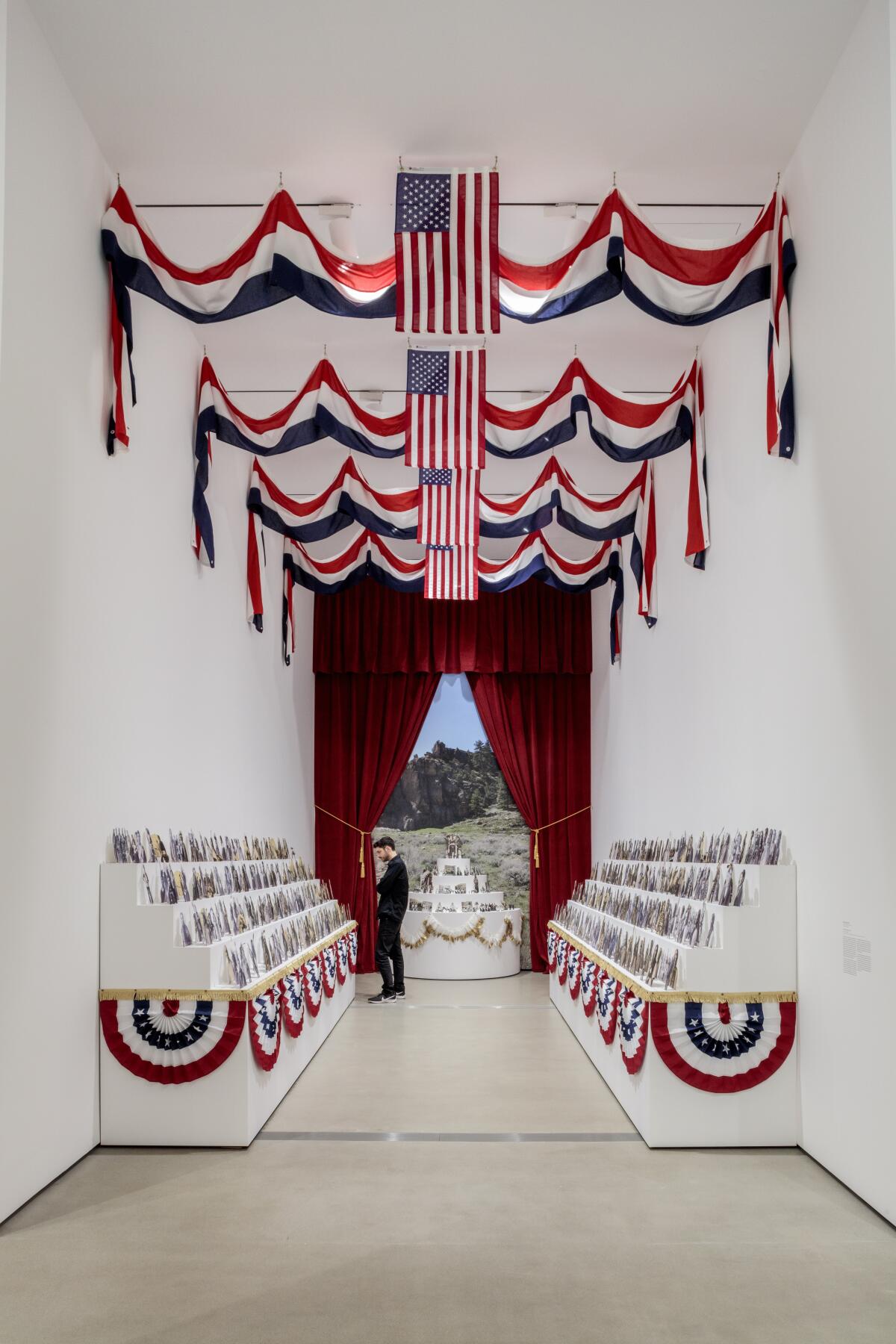
Rinehart’s photos (a set of which are maintained by the Omaha Public Library) serve as remarkable raw material in Red Star’s hands.
She has taken his portraits and cut away their formal backdrops, presenting the participants to the congress as silhouettes on a set of stepped shelves. It’s a design she borrowed from the expo itself: specifically, the stepped displays employed by agricultural concerns to show off regional fruits. At the far end of the display, she has included a separate set of images that Rinehart took around Red Star’s hometown of Pryor, Mont., as well as a color image of an Apsáalooke sacred site known as Baahpuuo. The entire installation is trimmed with red, white and blue bunting. (It is part of a group show at the Broad, curated by Sarah Loyer, that explores the ways in which artists have used the symbolism of the U.S. flag in their work.)
“The Indian Congress,” as Red Star’s piece is titled, is a stunner. It highlights the ways in which Native people have been put on display — in fairs, in museums, in photographs — while also subverting that very idea. The artist takes images of Indigenous figures made for the gaze of white society and reappropriates them, giving them literal dimension on the stepped platforms. To stand among them is to look into their faces — dapper, jaunty, sad, serious, beautiful and worn — and to feel as if, at any second, you might hear their chattering voices come to life.
It is a display, ultimately, that turns the viewer into the spectacle. To walk between the stepped platforms is to feel as if all of the Indigenous figures are seated in a grand reviewing stand and that they are gazing at you.
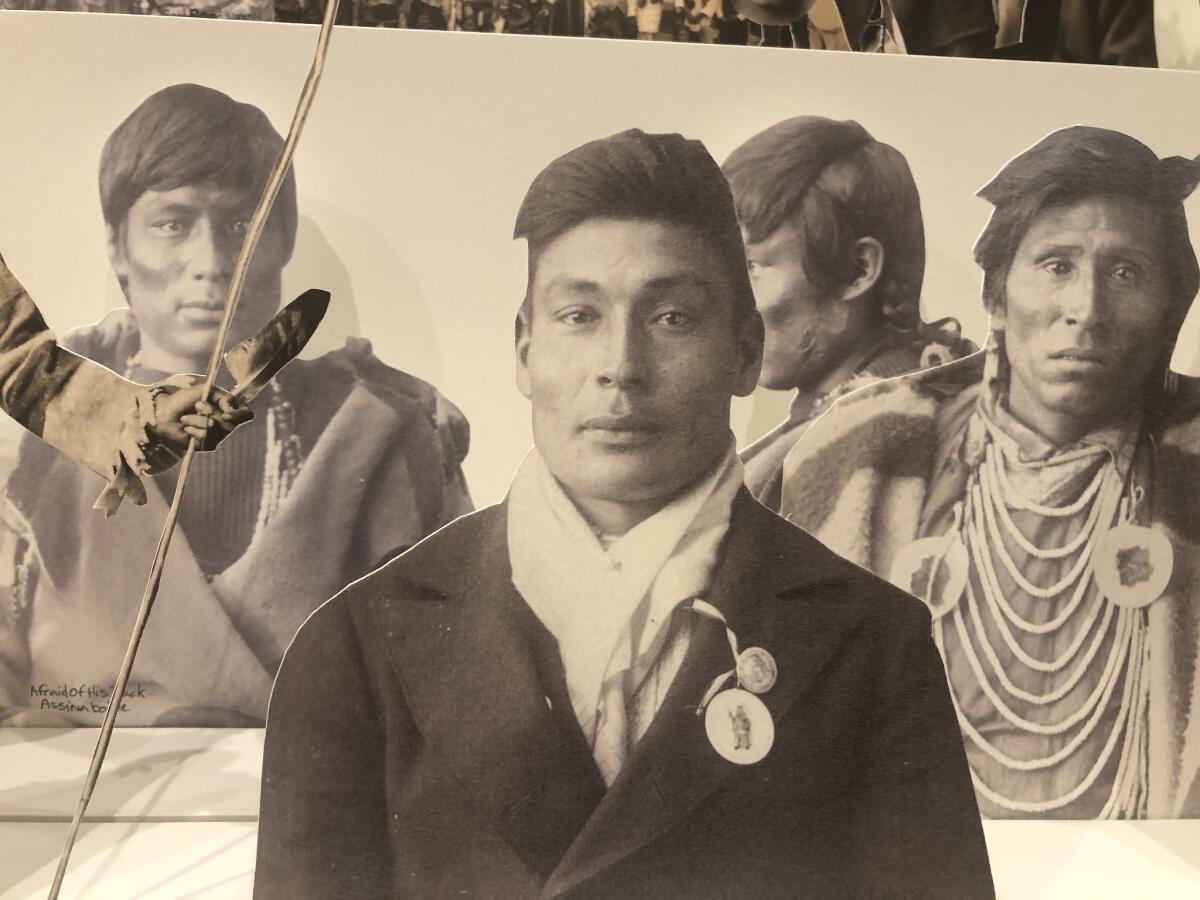
In a talk organized by Omaha’s Joslyn Art Museum last year (the piece is part of the museum’s permanent collection), Red Star said she was drawn to Rinehart’s images because they are “beautiful,” but also because they are extraordinarily well catalogued, including the name and tribal affiliation of each sitter, allowing scholars to dig into their individual histories. In Red Star’s case, that includes members of her own tribe.
But ultimately, her interest was most piqued by the gathering itself. “I was just in awe of the magnitude of 500 individual Native people gathering together,” she said. And in her work, she hoped to give viewers “maybe a tiny little bit of what that might have felt like.”
My best guess: remarkable and intensely bittersweet.
“This Is Not America’s Flag” is on view at the Broad through Sept. 25.
On for fall!
After a couple of years of pandemic, are we actually having a real-deal fall arts season? It appears that we are. And it’s blazing! Naturally, The Times has all the recommendations for music, TV, movies and muuuuuuch more:
Enjoying this newsletter? Consider subscribing to the Los Angeles Times
Your support helps us deliver the news that matters most. Become a subscriber.
In the fine arts, art critic Christopher Knight, classical music critic Mark Swed, theater critic Charles McNulty and I provide our list of go-tos. And we are a wide-ranging bunch, covering Tala Madani’s humorous paintings at MOCA as well as Matthew López’s “The Inheritance” at the Geffen Playhouse and John Adams’ anticipated production of “Antony and Cleopatra” at the San Francisco Opera.
As part of our coverage, culture writer Deborah Vankin previews the soon-to-open Orange County Museum of Art at its new Morphosis-designed home in Costa Mesa. Kicking off the proceedings will be the museum’s resuscitated biennial, which has been organized by a cross-generational trio of curators: Elizabeth Armstrong, Gilbert Vicario and Essence Harden.
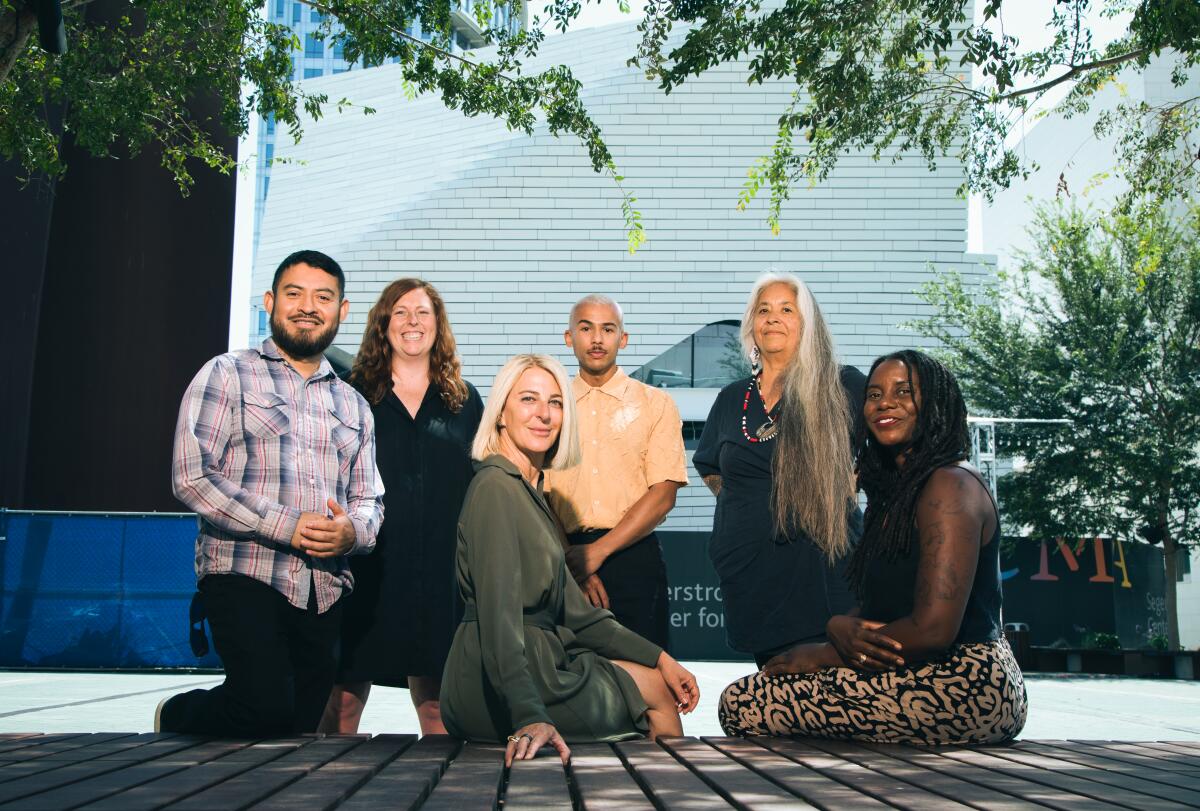
I also dip a toe over in the books section, which gathers the 30 must-reads for fall. This includes Namwali Serpell’s latest novel, “The Furrows,” and Javier Zamora’s “Solito,” a striking memoir about making the journey to the U.S. from El Salvador. For the list, I spoke with Central Valley native Manuel Muñoz about his new collection of short stories, “The Consequences,” which will be published in October. Lucid and elegantly written, his stories feature the Central Valley as a recurring character of enigmatic presence. Absolutely, positively pick it up!
Need more? You can find our full fall preview here.
Essential happenings
My colleague Matt Cooper has hit “refresh” on his regular list of cultural happenings and has now rounded up the best cultural events for the coming week (and beyond) in a new format that features a very handy map — so you know what’s going down near you. This list features dance, theater, music, art and much more — including a production of “Hair” at Charles Farnsworth Park in Altadena and composer John Williams conducting favorites from some of his most beloved film scores at the Hollywood Bowl.
Looking ahead to next week? You can find those deets in there too, including gigs by Wynton Marsalis at the Bowl and the opening of Judy Baca’s “World Wall” at MOCA.
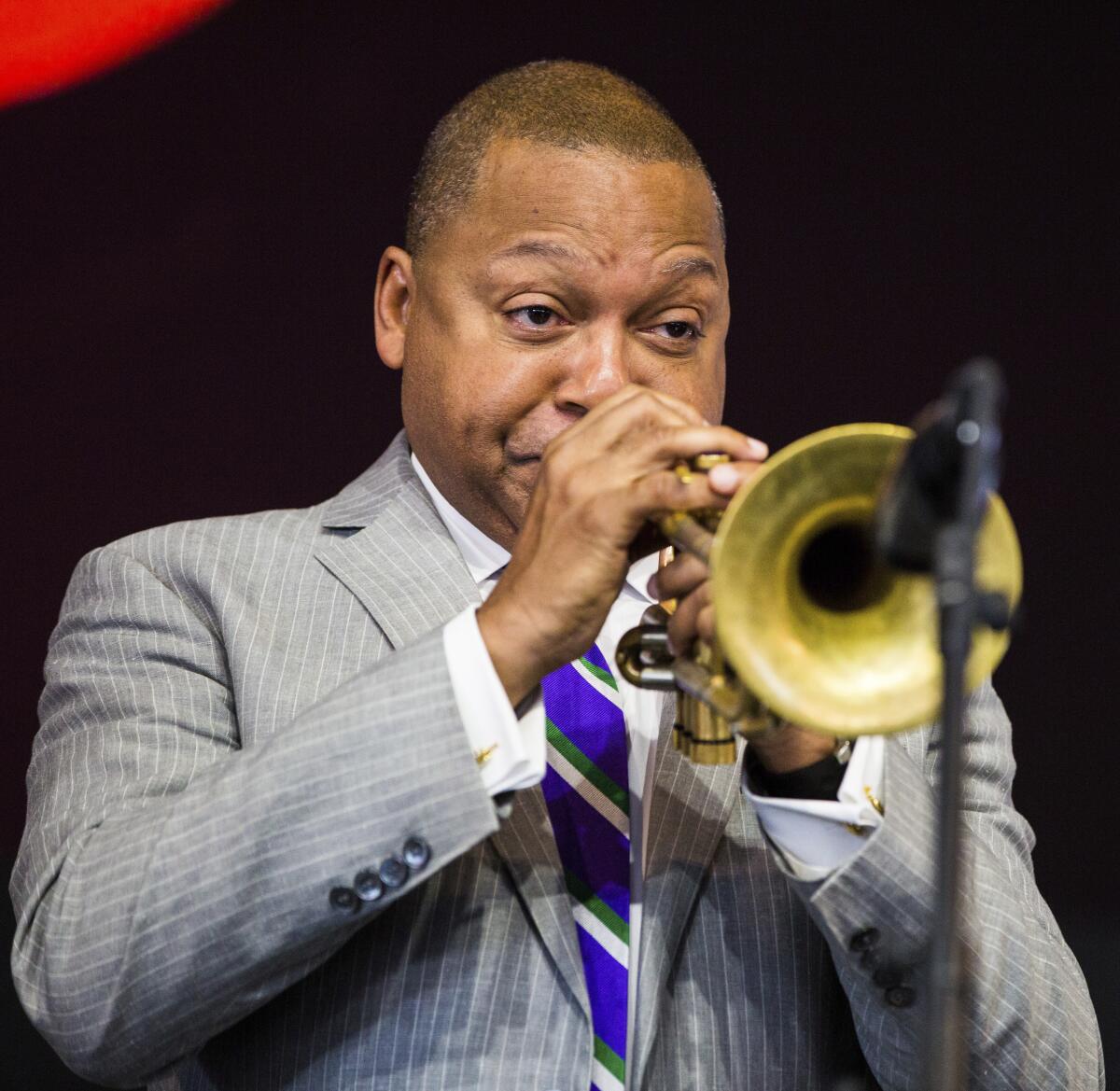
Visual arts
Christopher Knight has a look at a “compact and well-considered” exhibition of Cy Twombly’s work at the Getty Museum that “does a deep dive into the relationship between his well-known painterly abstractions, which emerged into prominence in the 1960s, and his obsession with the cultures of ancient Greece and Rome.” This includes paintings, works on paper and sculptures by Twombly, “interspersed with ancient Greek and Roman objects, most of them once owned by the artist and displayed in his home and studio.”
I skipped town for the cooler Bay Area, where I spent some quality time marinating in the work of Carlos Villa in a two-part retrospective at the Asian Art Museum and the San Francisco Arts Commission. The Filipino American artist, who shaped generations of students at the San Francisco Art Institute, created practically shamanic feathered paintings that drew heavily from non-Western traditions. As I note, these “are objects that speak to his roots but bear his bodily presence so intensely that they seem to speak out against Filipino American erasure.”
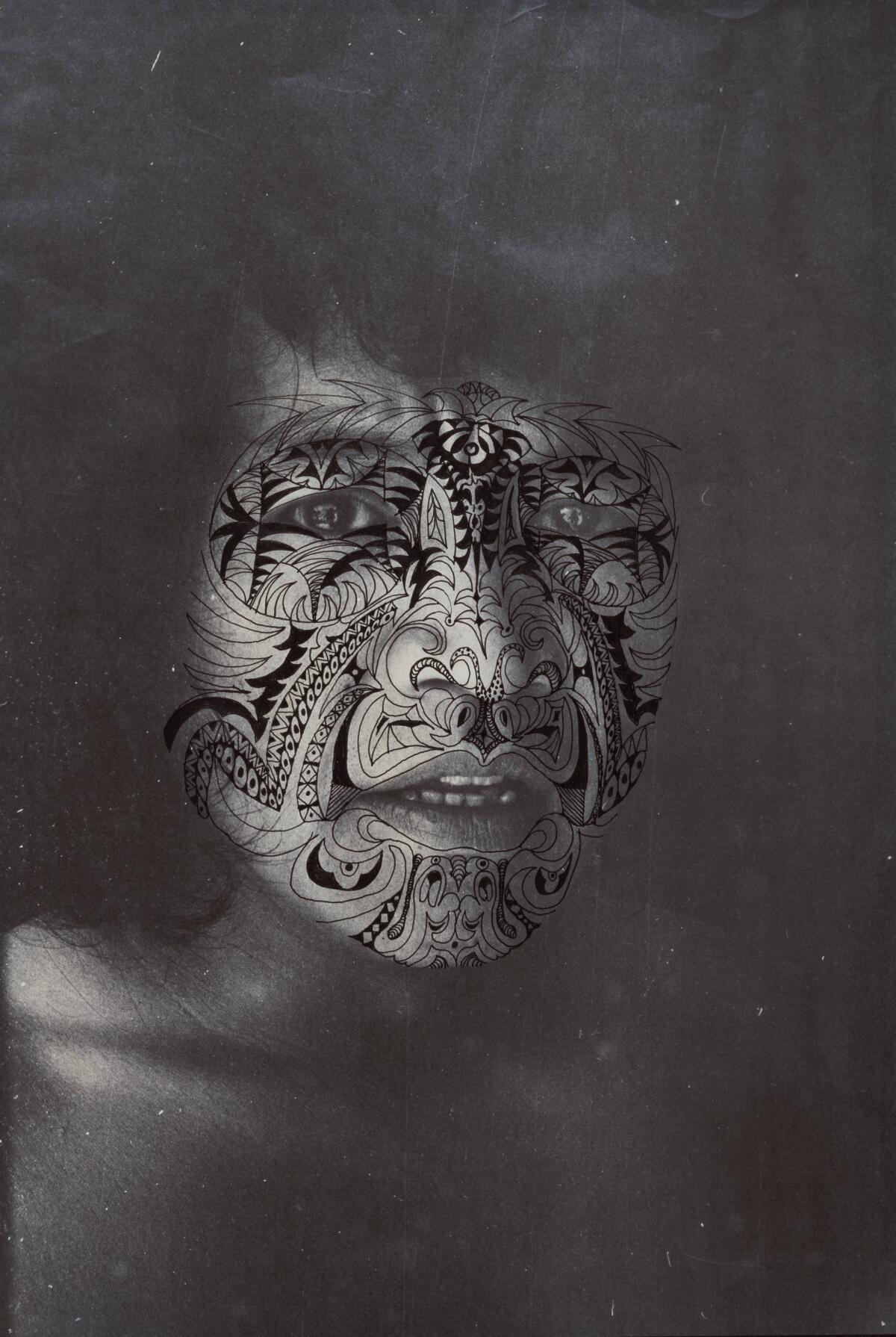
Artist Larissa Rogers, who is Afro Korean, has created a performative work of video art that employs the orange as potent symbol: It was orange juice that teenager Latasha Harlins was going to buy when she was killed by shopkeeper Soon Ja Du in 1991 — an incident that was a critical precursor to the police beating of Rodney King. Rogers talked to Daily Pilot writer Sarah Mosqueda about “We’ve Always Been Here, Like Hydrogen, Like Oxygen,” on view at the Grand Central Art Center in Santa Ana: “There are so many gaps and separations between being able to understand each other and each other’s experiences.”
Classical notes
Finnish conductor Eva Ollikainen made her Hollywood Bowl debut this past week — featuring Beethoven’s Ninth, no less. The performance also included a presentation of Canadian composer Samy Moussa’s “Elysium.” Times classical music critic Mark Swed writes of Ollikainen: “Rather than following the mystery of Moussa with Beethoven’s own primordial symphonic opening, she emphasized primordial percussion, dinosaurs pounding the earth.” The sensation, he adds, “was that of Beethoven coming straight at you, no ducking.”

Plus, Joshua Barone of the New York Times has a good profile of John Adams in advance of “Antony and Cleopatra” landing in San Francisco. “A pop star Adams isn’t,” he writes, “but he is one of the few composers who approaches that status, second only, perhaps, to [Philip] Glass.”
On and off the stage
Grammy-, Emmy- and Tony-winning singer Ben Platt — who has appeared in Broadway productions such as “Dear Evan Hansen” and “Book of Mormon” — will be making some solo appearances at the Rady Shell in San Diego and the Hollywood Bowl. Because of the pandemic, it’s been three years since he took the stage for a full show. And though the tour for “Reverie,” his current album, has him feeling jitters, he tells the San Diego Union-Tribune’s Abby Hamblin that he also feels “pure excitement” to get back to doing what he loves doing most.

Lea Michele is set to take the stage in the title role of “Funny Girl” on Broadway — her first major role since allegations surfaced of her bullying behavior on set. In an interview published this week, she addresses the charges. “I really understand the importance and value now of being a leader,” she told Julia Jacobs of the New York Times. “It means not only going and doing a good job when the camera’s rolling, but also when it’s not. And that wasn’t always the most important thing for me.”
New York Times theater critic Jesse Green has a really interesting piece on how some theaters are reimagining the concept of theater for the age of equity. Some of it involves being less wedded to the bricks and mortar.
It brings the room together
I’ve been obsessing about the casino-style rug and the box of framed Time magazine covers in that FBI photo of the top-secret documents seized at Mar-a-Lago.
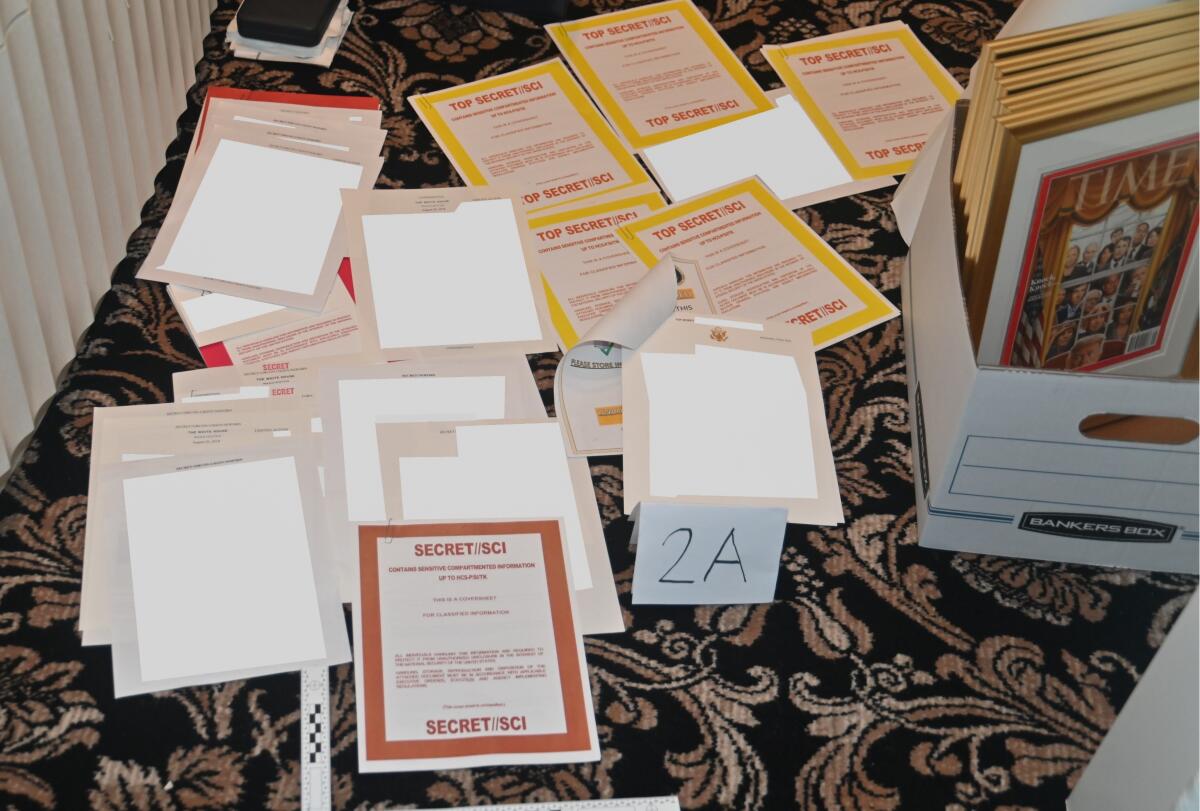
Thankfully, there are those who are more obsessed: Josh Kovensky of Talking Points Memo interviewed New York City rug dealer Richard Afkari, who described the rug’s design history — an arabesque pattern that, over several centuries, has been filtered through the various artistic traditions of European nations to end up as wall-to-wall carpet in Florida. He also added: “If it were one of my workers with invoices thrown around like that, I would call the police.”
Here’s hoping that artist Cayetano Ferrer can lay his hands on a chunk of it for one of his casino carpet collages.
Moves
Matt Shakman is stepping down as artistic director of the Geffen Playhouse. Shakman, who has been in the role since 2017 — and also directs for film and TV — tells The Times’ Jessica Gelt that it was getting increasingly difficult to balance his work for the stage and for Hollywood.
Ellen Richards has resigned as executive producing director at the Laguna Playhouse after six years in the role.
Conductor Daniel Barenboim has withdrawn from a new production of Wagner’s Ring Cycle at the Berlin State Opera for health reasons.
Passages
Ruby C. Williams, a Florida folk artist known for the clever, luscious signs she painted for her fruit stand, has died at 94.
Robert LuPone, an actor and dancer who originated the role of the director in “A Chorus Line” on Broadway and helped establish the off-Broadway company Manhattan Class Company (later to become MCC Theater), is dead at 76.
Jaimie Branch, a trumpet player and composer known for combining “punk ferocity with advanced technique,” has died at 39.
In other news...
— As a follow-up to the story I did last week about student labor at SCI-Arc and architect Tom Wiscombe’s Sunset Strip billboard, I found this 2016 essay on architectural education by Peter Martinez Zellner, who used to teach at SCI-Arc, intriguing.
— Employees of Bernheimer Architecture in New York announced they were unionizing, in what appears to be the only formal union at a private-sector architecture firm in the U.S.
— The labor union representing employees at the Philadelphia Museum of Art has filed eight unfair labor practice charges against museum management.
— The International Council of Museums has revised its definition of museums.
— The New York attorney general is investigating Sotheby’s for an alleged tax fraud scheme.
— Rethinking the design of restaurant restrooms.
— Check out this map of L.A. buildings by Black architects.
— A book that honors the bad review.
And last but not least ...
Times photographer Marcus Yam has reported extensively on the humanitarian crises generated by conflicts in Ukraine and Afghanistan. Currently, he is tooling around Kabul and has been texting me informal smartphone snapshots of building façades. I’ve been curious about the extravagant architecture that was built during the U.S. occupation, as well as the “poppy palaces,” so called for their ostensible connection to the opium trade. The buildings are still going. What is far more uncertain are the lives of the people who live within and beyond their walls.

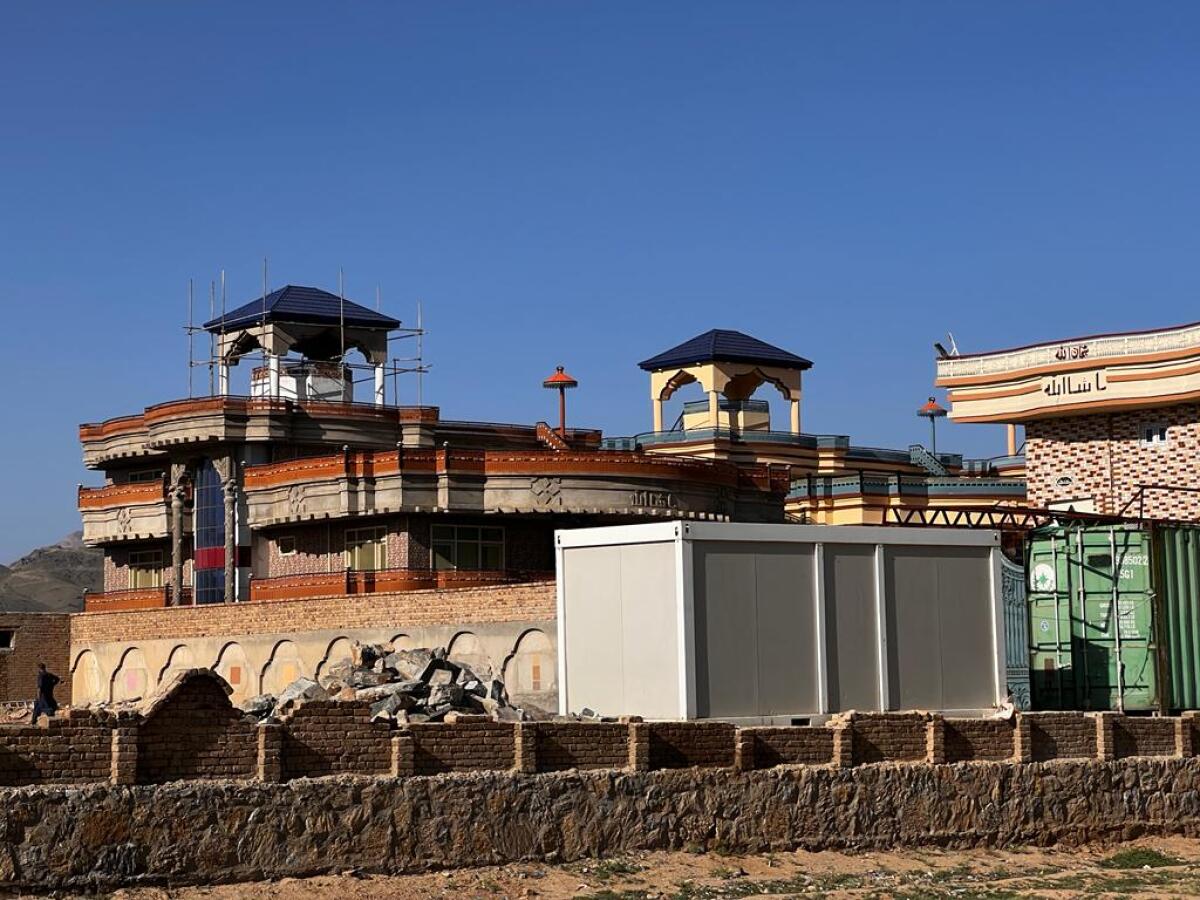
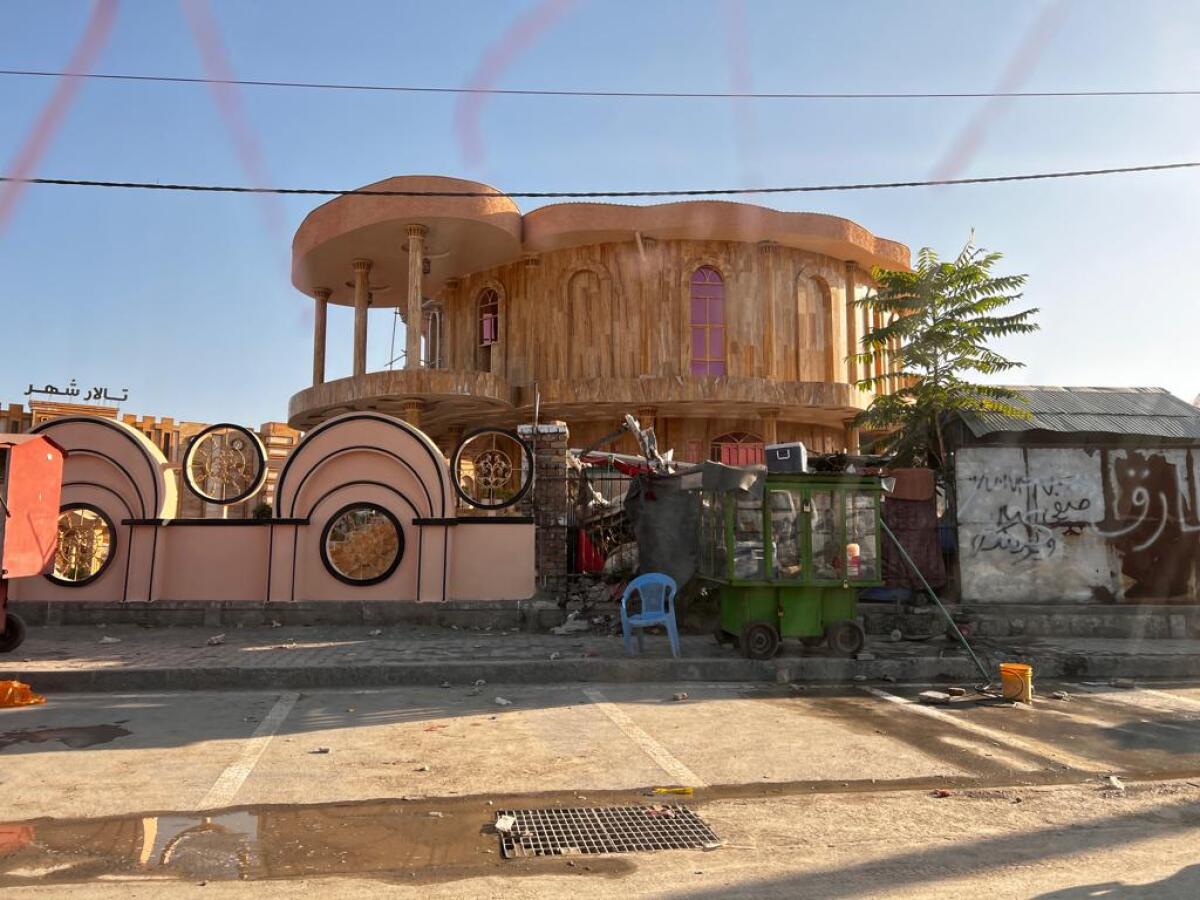
The biggest entertainment stories
Get our big stories about Hollywood, film, television, music, arts, culture and more right in your inbox as soon as they publish.
You may occasionally receive promotional content from the Los Angeles Times.




